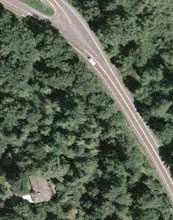Hope you all had a great weekend. Back to our landscaping. Let me explain how we installed drip irrigation for the raised bed. The process is fairly simple.
 First drill a hole completely through the end 12" from the top, centered from side to side. We drilled our hole at the deepest end, but either end would be fine. Then run a piece of tubing (cut to length plus a few inches) through the hole.
First drill a hole completely through the end 12" from the top, centered from side to side. We drilled our hole at the deepest end, but either end would be fine. Then run a piece of tubing (cut to length plus a few inches) through the hole.
On the inside of the bed, attach the hardware to the tubing. Next, figure out where your lines need to run in order to irrigate the entire bed. Our bed has an interior width of 4' and each line has a 24" spread (12" on each side). So, our lines lay 12" from the edge with a 24" space in the middle. Insert the mounting piece for each line.
On the outside of the bed, attach and adapter/pressure meter for the garden hose. Be sure your pressure meter is in accordance with the manufacturer's recommendation. Our lines are manufactured for 15 psi.

Attach your lines and run them the length of the bed. Drip irrigation is more efficient if the lines are not kinked under the soil so be sure they are flat on the ground. At the far end, slice the tubing to the appropriate length plus 6-8". Cut two more pieces approximately 2" long. Fold the end of one line several times and slip one of the 2" pieces on to secure it closed. Repeat on each line.
The lines are 12" under the surface for a couple of reasons: 1) the water won't evaporate as quickly as if it were near/on the top, and 2) this depth allows us to use the tiller at a maximum 8" depth without interfering with the drip lines.
 Now it's time to test the system for leaks. Gently turn on the water and increase pressure until you've achieved the recommended force. In a few seconds, the water should be gently dripping onto the ground. Check all connections for leaks. If nothing is leaking, you're done for the day!
Now it's time to test the system for leaks. Gently turn on the water and increase pressure until you've achieved the recommended force. In a few seconds, the water should be gently dripping onto the ground. Check all connections for leaks. If nothing is leaking, you're done for the day!Our reward? One happy garden!!







1 comment:
Well thought out and explained. the new place seems to have a complete drip system. At least I won't kill the plants for lack of water. I have so much to learn about trees and plants.
Post a Comment